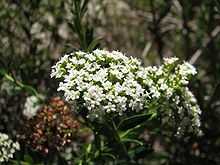Platysace lanceolata
| Platysace lanceolata | |
|---|---|
 | |
| Scientific classification | |
| Kingdom: | Plantae |
| (unranked): | Angiosperms |
| (unranked): | Eudicots |
| (unranked): | Asterids |
| Order: | Apiales |
| Family: | Apiaceae |
| Subfamily: | Hydrocotyloideae |
| Genus: | Platysace |
| Species: | P. lanceolata |
| Binomial name | |
| Platysace lanceolata (Labill.) Druce | |
Platysace lanceolata, commonly known as Shrubby Platysace, is a shrub species that is native to south-eastern Australia. It grows to 1.5 metres high and has leaves that are 10 to 50 mm long and 4 to 5 mm wide. Plants produce umbels of small white 5-petalled flowers between December and February in the species native range.[1]
The species was first formally described by French naturalist Jacques Labillardière in 1805 in the first volume of Novae Hollandiae Plantarum Specimen and given the name Azorella lanceolata. The species was transferred to the genus Platysace in 1917 by English botanist George Claridge Druce.[2]
References
- ↑ Wild Plants of Victoria (database). Viridans Biological Databases & Department of Sustainability and Environment. 2009.
- ↑ "Platysace lanceolata". Australian Plant Name Index (APNI), IBIS database. Centre for Plant Biodiversity Research, Australian Government, Canberra. Retrieved 4 September 2011.